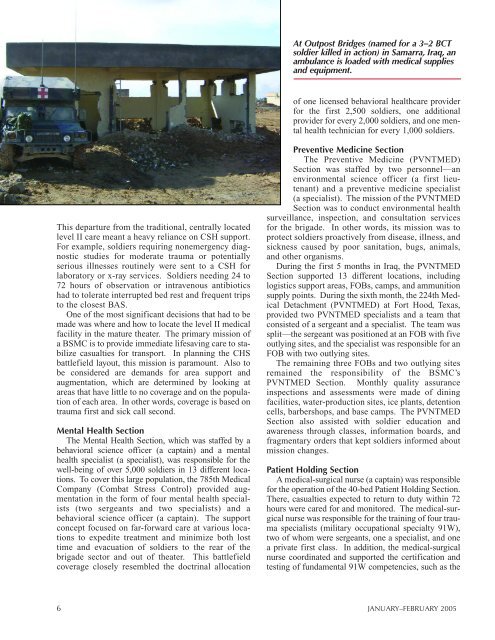Supporting the First Stryker Brigade in Iraq - Army Logistics ...
Supporting the First Stryker Brigade in Iraq - Army Logistics ...
Supporting the First Stryker Brigade in Iraq - Army Logistics ...
You also want an ePaper? Increase the reach of your titles
YUMPU automatically turns print PDFs into web optimized ePapers that Google loves.
This departure from <strong>the</strong> traditional, centrally located<br />
level II care meant a heavy reliance on CSH support.<br />
For example, soldiers requir<strong>in</strong>g nonemergency diagnostic<br />
studies for moderate trauma or potentially<br />
serious illnesses rout<strong>in</strong>ely were sent to a CSH for<br />
laboratory or x-ray services. Soldiers need<strong>in</strong>g 24 to<br />
72 hours of observation or <strong>in</strong>travenous antibiotics<br />
had to tolerate <strong>in</strong>terrupted bed rest and frequent trips<br />
to <strong>the</strong> closest BAS.<br />
One of <strong>the</strong> most significant decisions that had to be<br />
made was where and how to locate <strong>the</strong> level II medical<br />
facility <strong>in</strong> <strong>the</strong> mature <strong>the</strong>ater. The primary mission of<br />
a BSMC is to provide immediate lifesav<strong>in</strong>g care to stabilize<br />
casualties for transport. In plann<strong>in</strong>g <strong>the</strong> CHS<br />
battlefield layout, this mission is paramount. Also to<br />
be considered are demands for area support and<br />
augmentation, which are determ<strong>in</strong>ed by look<strong>in</strong>g at<br />
areas that have little to no coverage and on <strong>the</strong> population<br />
of each area. In o<strong>the</strong>r words, coverage is based on<br />
trauma first and sick call second.<br />
Mental Health Section<br />
The Mental Health Section, which was staffed by a<br />
behavioral science officer (a capta<strong>in</strong>) and a mental<br />
health specialist (a specialist), was responsible for <strong>the</strong><br />
well-be<strong>in</strong>g of over 5,000 soldiers <strong>in</strong> 13 different locations.<br />
To cover this large population, <strong>the</strong> 785th Medical<br />
Company (Combat Stress Control) provided augmentation<br />
<strong>in</strong> <strong>the</strong> form of four mental health specialists<br />
(two sergeants and two specialists) and a<br />
behavioral science officer (a capta<strong>in</strong>). The support<br />
concept focused on far-forward care at various locations<br />
to expedite treatment and m<strong>in</strong>imize both lost<br />
time and evacuation of soldiers to <strong>the</strong> rear of <strong>the</strong><br />
brigade sector and out of <strong>the</strong>ater. This battlefield<br />
coverage closely resembled <strong>the</strong> doctr<strong>in</strong>al allocation<br />
6<br />
At Outpost Bridges (named for a 3–2 BCT<br />
soldier killed <strong>in</strong> action) <strong>in</strong> Samarra, <strong>Iraq</strong>, an<br />
ambulance is loaded with medical supplies<br />
and equipment.<br />
of one licensed behavioral healthcare provider<br />
for <strong>the</strong> first 2,500 soldiers, one additional<br />
provider for every 2,000 soldiers, and one mental<br />
health technician for every 1,000 soldiers.<br />
Preventive Medic<strong>in</strong>e Section<br />
The Preventive Medic<strong>in</strong>e (PVNTMED)<br />
Section was staffed by two personnel—an<br />
environmental science officer (a first lieutenant)<br />
and a preventive medic<strong>in</strong>e specialist<br />
(a specialist). The mission of <strong>the</strong> PVNTMED<br />
Section was to conduct environmental health<br />
surveillance, <strong>in</strong>spection, and consultation services<br />
for <strong>the</strong> brigade. In o<strong>the</strong>r words, its mission was to<br />
protect soldiers proactively from disease, illness, and<br />
sickness caused by poor sanitation, bugs, animals,<br />
and o<strong>the</strong>r organisms.<br />
Dur<strong>in</strong>g <strong>the</strong> first 5 months <strong>in</strong> <strong>Iraq</strong>, <strong>the</strong> PVNTMED<br />
Section supported 13 different locations, <strong>in</strong>clud<strong>in</strong>g<br />
logistics support areas, FOBs, camps, and ammunition<br />
supply po<strong>in</strong>ts. Dur<strong>in</strong>g <strong>the</strong> sixth month, <strong>the</strong> 224th Medical<br />
Detachment (PVNTMED) at Fort Hood, Texas,<br />
provided two PVNTMED specialists and a team that<br />
consisted of a sergeant and a specialist. The team was<br />
split—<strong>the</strong> sergeant was positioned at an FOB with five<br />
outly<strong>in</strong>g sites, and <strong>the</strong> specialist was responsible for an<br />
FOB with two outly<strong>in</strong>g sites.<br />
The rema<strong>in</strong><strong>in</strong>g three FOBs and two outly<strong>in</strong>g sites<br />
rema<strong>in</strong>ed <strong>the</strong> responsibility of <strong>the</strong> BSMC’s<br />
PVNTMED Section. Monthly quality assurance<br />
<strong>in</strong>spections and assessments were made of d<strong>in</strong><strong>in</strong>g<br />
facilities, water-production sites, ice plants, detention<br />
cells, barbershops, and base camps. The PVNTMED<br />
Section also assisted with soldier education and<br />
awareness through classes, <strong>in</strong>formation boards, and<br />
fragmentary orders that kept soldiers <strong>in</strong>formed about<br />
mission changes.<br />
Patient Hold<strong>in</strong>g Section<br />
A medical-surgical nurse (a capta<strong>in</strong>) was responsible<br />
for <strong>the</strong> operation of <strong>the</strong> 40-bed Patient Hold<strong>in</strong>g Section.<br />
There, casualties expected to return to duty with<strong>in</strong> 72<br />
hours were cared for and monitored. The medical-surgical<br />
nurse was responsible for <strong>the</strong> tra<strong>in</strong><strong>in</strong>g of four trauma<br />
specialists (military occupational specialty 91W),<br />
two of whom were sergeants, one a specialist, and one<br />
a private first class. In addition, <strong>the</strong> medical-surgical<br />
nurse coord<strong>in</strong>ated and supported <strong>the</strong> certification and<br />
test<strong>in</strong>g of fundamental 91W competencies, such as <strong>the</strong><br />
JANUARY–FEBRUARY 2005







